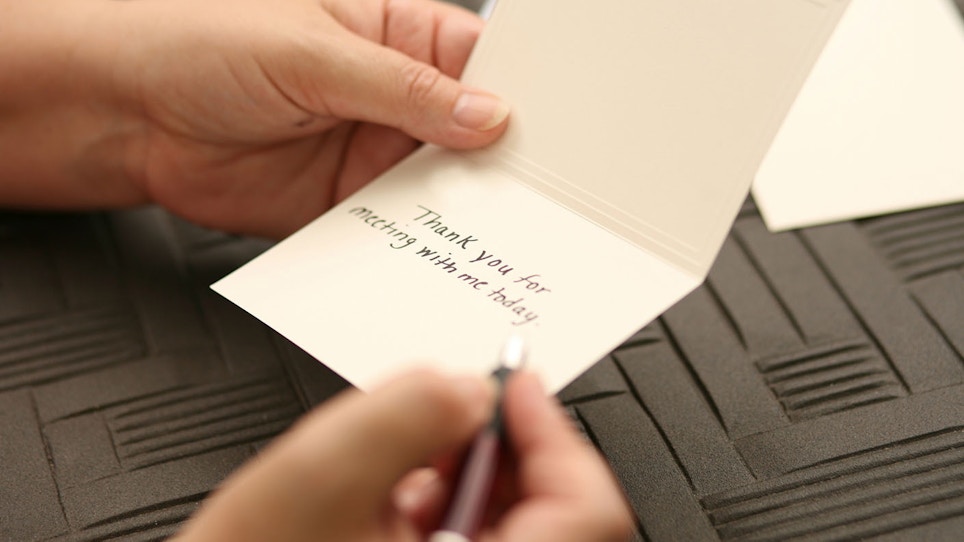If you’re grateful but don’t take the time tell anyone, does it count? Maybe, but it’s a bit like clapping with one hand. You know you’re doing it, but does anyone else? Probably not. When shown appropriately, gratitude has tremendous power in the world of small business. At a minimum, it will keep you from appearing like an ungrateful and uncouth toad. On the other end of the spectrum, well-expressed thanks can open doors, solidify working relationships and help build your business. The key to giving and getting with gratitude is knowing who to thank, when to thank them, and how to do it.
Who to Thank
Thank your crew, your suppliers and your customers.
Thank your hardworking employees. Maybe your team worked long hours at a special event over the weekend. Maybe an individual worker put in extra effort this week. Perhaps an employee who has had a hard time meeting expectations finally does so. If you want those types of activities to continue to occur on any kind of regular basis, you need to recognize them.
Thank the folks who help you pay the bills. Customers, colleagues and suppliers will support you if they feel you acknowledge their efforts. If you want to grow and build your network and workplace support system, those are the people you must cultivate. Doesn’t it make sense to nurture the relationships you have with them?
When to Thank
The world would be a kinder and gentler place if people displayed more grace. Can you imagine how your workplace would function if everyone expressed sincere gratitude at least once an hour? Motivated, appreciated and valued are some possibilities that come to mind. When you think about it, once an hour may be a bit much at first, but it is not a bad goal to work toward.
And as with most activities, the more you do it, the easier it will become. But be warned: You must choose well. Recognizing people inappropriately is worse than not recognizing them at all.
For example, ask any kid how much a certificate, award or trophy received for some trivial activity meant to him. If you don’t already know, the answer is a whole lot of “zero.” Kids are not stupid, and neither are the big people they turn into.
Gratitude should feel real and be relevant. If either one of those elements is missing, your “thank you” will most likely seem hollow.
How to Thank
The words “thank you” are an adequate choice for acknowledging common courtesies shown to you. However, when people go beyond the basics, your recognition should as well. By following a few simple guidelines, you can quickly and easily step up your gratitude game.
Get specific. Focus on a detail, and your “thank you” will mean more. For instance, “The lemon muffins you made and brought into the shop today were some of the best I’ve ever had. The glaze was amazing. You were so thoughtful to share them with us.” That’s a whole lot better than “Thanks for the muffins.”
Get personal. Share with others how what they’ve done meant something to you, and your thanks will both seem and be more sincere. With a little thought, you can connect feelings to the most mundane topics. For example, “John, I wanted to tell you how much I appreciated your effort to get that delivery truck back on the road this afternoon. Your ability to diagnose and fix a mechanical problem saved us time and money today.”
Get creative. Ironically, the phrase “thank you” hinders most people’s ability to express gratitude effectively. Avoid using the phrase at the start of your sentences, and you’ll find you are more imaginative. For instance, “Thank you for coming in early for the safety meeting and asking questions. The entire crew benefitted from your active participation.” That’s OK, but consider the following: “I think everyone learned some valuable safety lessons at this morning’s meeting. Your contributions helped all of us stress the importance of being careful on the job. I appreciate your help promoting safety.” The second choice is stronger and it doesn’t use the words “thank you.”
Get to your keyboard. Email is appropriate when a verbal “thank you” seems a bit inadequate or is not possible when your customers and suppliers are hard to reach by phone. Although you don’t want to fill people’s inboxes with unnecessary messages, recognize that for most folks, it is a pleasure to receive an occasional note of appreciation among the usual dreck. Start typing.
Get out your stationery. If you really want to show your thanks, think old school. These days, handwritten notes are few and far between, so when you take the time to craft one, it won’t go unnoticed. Write at least three sentences using your best penmanship, focus on a detail, and tell your recipients how what they’ve done for you has made a difference.
The Bottom Line
So there you have it: the who, what and how of a good “thank you.” And at this point, if you are still reading, I sincerely appreciate your taking the time to consider these ideas. As you might imagine, it’s great to feel as if what you have to say might be useful to someone. You’ve made my day. Thank you!
Kate Zabriskie develops customer service strategies and training programs as president of Maryland-based Business Training Works. For more information, visit www.businesstrainingworks.com.






